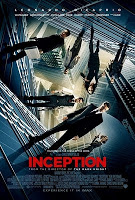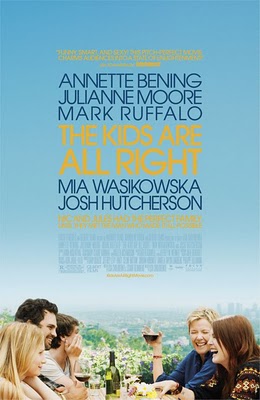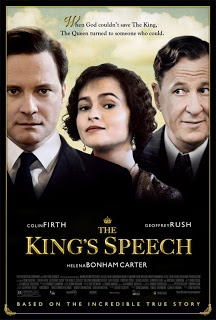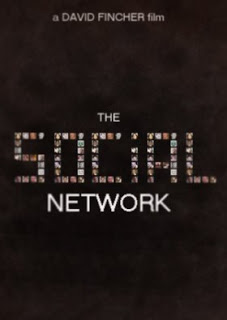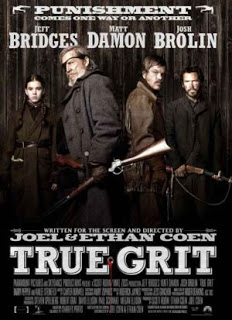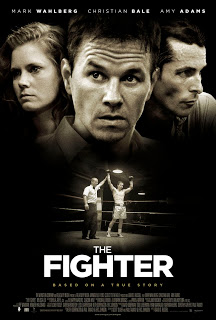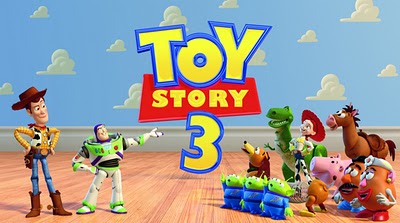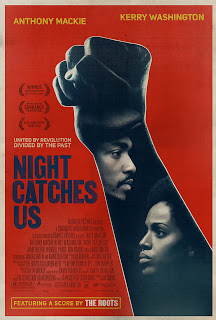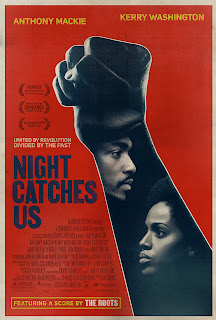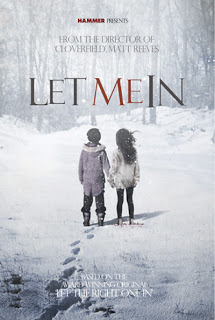This is a guest review from Cynthia Arrieu-King
The Coen Brothers have triumphed in recognizing that their particular wifty and broad take on American violence could better the classic Western film True Grit . The original 1969 version drew from the campy Western novel True Grit by Charles Portis
. The original 1969 version drew from the campy Western novel True Grit by Charles Portis , and had a play-time, hokey quality. On initial comparison, the Coens made a shot for shot remake. Lucky for us, they don’t skimp on corpses, pith and the comic relief that witless people who think they are witty and witty people used to being considered witless both provide. Jarmusch could have made a mystical emotional version of this film à la Dead Man
, and had a play-time, hokey quality. On initial comparison, the Coens made a shot for shot remake. Lucky for us, they don’t skimp on corpses, pith and the comic relief that witless people who think they are witty and witty people used to being considered witless both provide. Jarmusch could have made a mystical emotional version of this film à la Dead Man . But that is not the point of this film. The point is un-sentimentality and a little bizarre humor in the face of ruthless, emotionless terrain, a terrain the Coens know well.
. But that is not the point of this film. The point is un-sentimentality and a little bizarre humor in the face of ruthless, emotionless terrain, a terrain the Coens know well.
I cannot talk about the feminist angle of the film without major spoilers, but suffice it to say, I could not believe what I was seeing in the main character of Hailee Steinfeld’s Mattie Ross. First, a brief discussion of the men and the scenery: it’s hard to say who was not stealing the scene from whom, man or woman or child, the length of this movie.
Jeff Bridges has taken his knack for laconic, comic outrage (The Big Lebowski ) and muffled it down. His face has obliged us with a certain amount of real age. Towards the film’s end we understand that his emotion or caring will always be submerged in deference to what must be done, duty carried out with bodily instinct. Somehow Bridges never quite makes you consider whether or not Cogburn is a good or bad man. He is perpetually moving forward and comes to terms with what is and what is not possible without showing the sweat of a single emotional calorie. But you can sense that emotion is happening somewhere within, far within. There are plenty of John Wayne fanatics who post web comments on the Duke’s superiority to any possible actor in the role of Rooster Cogburn. This is nostalgia.
) and muffled it down. His face has obliged us with a certain amount of real age. Towards the film’s end we understand that his emotion or caring will always be submerged in deference to what must be done, duty carried out with bodily instinct. Somehow Bridges never quite makes you consider whether or not Cogburn is a good or bad man. He is perpetually moving forward and comes to terms with what is and what is not possible without showing the sweat of a single emotional calorie. But you can sense that emotion is happening somewhere within, far within. There are plenty of John Wayne fanatics who post web comments on the Duke’s superiority to any possible actor in the role of Rooster Cogburn. This is nostalgia.
Matt Damon, the other main male character in this film, does his fake-nosed straight-man in shades of ridiculous pride and earnestness (as seen in The Oceans movies, Inside Job
movies, Inside Job ). He sees the law and is seized by it in a way Bridges’ Cogburn never is, and proves how thinking within the law will never get the job done. I mean, something pretty bad happens to his tongue; this never gets him to stop nattering on with supposed reasonableness. If everyone in this movie is a variation on the idea of true grit in a nation of True Grit, his Texas Ranger LaBoeuf might have a few grains less than the others and can live with his own humiliations.
). He sees the law and is seized by it in a way Bridges’ Cogburn never is, and proves how thinking within the law will never get the job done. I mean, something pretty bad happens to his tongue; this never gets him to stop nattering on with supposed reasonableness. If everyone in this movie is a variation on the idea of true grit in a nation of True Grit, his Texas Ranger LaBoeuf might have a few grains less than the others and can live with his own humiliations.
The West looks more Zen, bosky, and alien through Roger Deakins’ cinematography; when things go wrong they are comic in an impromptu, a limitless space.
There is a dentist who pretty much steals the movie for at least 4 minutes, but I won’t spoil that for you.
Now for the main character of the story: Mattie Ross, also the narrator.
When watching the sloppily lethal Rooster Cogburn and the persistent young narrator of this movie interact, one can sense a power dynamic both odd and pleasing. I felt as if an old favorite doll had been put up at the dining room table with a real plate finally—Mattie Ross as Cogburn’s—as he calls her—“baby sister”.
Fine. I don’t know yet how to adequately express my astonishment that not only is the main character of this movie a 14 year-old girl, she is not a 14 year-old girl who gets swept aside, despite the men trying to sweep her aside—and actually dumping her off in the middle of nowhere with some gnarly thugs—for most of the movie. Her resolve is not plucky, it is near maniacal. They can’t get rid of her because she is irrationally rational. My jaw hung open a few times. This of course doesn’t necessarily confirm a feminist message about girl-child power, because she is not exactly a woman, she is a child entertaining in her single-mindedness. The story mostly emphasizes that if you want to be gritty, don’t get side-tracked in the vagaries of your emotion; have forethought and a long-range plan and wield a lawsuit adamantly until you are a nuisance that can’t be ignored. Steinfeld too never shows the processing of her emotions; the comebacks come as if her brain is mostly Intel Inside Core i5. The little black stable-boy in this movie has a conversation with Mattie as she retrieves a horse that ends with something like, “I can’t tell my boss what you said because he told me never to utter your name again.”
This spectacle of bullheaded feminine autocracy disguised as reason isn’t quite human and doesn’t necessarily do the male gender any favors either. The film’s minor men get to be idiots and the most reasonable and faintly kind ones get shot or maimed extra. To get ahead as a man, don’t think, don’t be kind; your best bet is to be emotionless too.
Okay, really, SPOILER ALERT. This girl wants to kill the man who killed her father. There is only an opening shot on this father’s dead body being snowed on. There is no narrative ramp-up besides this. And holy cow if she does not KILL, all by herself, messily, with purpose, her father’s killer—Tom Chaney. You think for a second someone else will do it. You think for a second Rooster will come back and save her. You are not totally wrong, but he really does leave her alone with this killer who turns out to be the most human of them all; remorseless and real. You might even think it’s a Coen movie, something god-awful is about to happen to her. I don’t know if it’s the shock this delivers to the viewer that a girl could grab the brass ring in this way, or relief that finally a girl gets to carry out the climactic plot point of a movie, but she does it. I didn’t even let myself think the Coens would allow this, which says more about my forgetting that one of them is married to Frances McDormand. Then Mattie falls into a giant hole and gets her girlish shrieks out that way. Well, she’s not a fucking Marine now, is she.
Is it a feminist movie? I think that it satisfies on many levels: the main character is a woman/girl, she wants revenge, to exercise her will, and she does it. She gets a little help, and some protection and some shot-up cornbread for her fifty dollars (which she actually never has to pay to Rooster). Though we have no narrative slip on which to fit our emotional understanding of her motivations, we go along with it. (To handicap myself as a reviewer: I have lost my father, I wanted to kill someone, I was a Daddy’s girl; as far as illustrating motivation goes, I’m like; what is there to explain?) But standing back, I can see that this sentimental premise was really nothing to have feared and the Coen Brothers didn’t have room or make room to deliver one of their painful montages or confrontations that sucks the emotion out of a wound and spits it in the viewer’s face as an explanation for Mattie’s drive.
So what to make of Mattie and Rooster’s relationship? Are they brother/sister, since he refers to her as baby sister? Are they weirdly, latently romantically linked? Are they father/daughter or uncle/niece? The movie gifts the weirdness of their dynamic and never allows it to settle into anything other than what it is. By the time Mattie (spoiler alert) dunks her water bucket erroneously into the creek and sees Tom Chaney for the first time, there isn’t much Rooster can do but ride away at the behest of her captors. And so he is neither a father, because what father would leave his child be? And he is not a brother, for the same reasons. He is not a friend. It is the coolness of his relationship to his own feelings that permits him both to enable her revenge and protect her with soldier-like strategy. Money never changes hands: perhaps it is only possible to be a woman who owns her revenge if she is actually only a child and if one steps out of capitalism’s systems.
In fact, this lack of sentimentality in the girl and the man allows them to be mirrors and strangely see themselves in each other. Their only credibility with each other: overarching determination. As Cogburn says when Mattie rides across the river on her horse—though this is obviously bullheaded and wreckless–he says, “She reminds me of me” and this is the first time he bothers to heed her. They work as a team because Mattie provides the reasonableness and Cogburn provides the instinct.
In the end it is the thrilling climax of the movie, the death of Tom Chaney, that pulls the biggest feminist punch, for I never saw it coming. This says more about viewer expectation and all westerns about revenge, and all those portraying high-pitched know-it-all girls in campy movies of any era. I think I might have had tears of happiness. Because the movie extends the reach of true violence and decision to a girl, it offers us a vision of grit as all-permeating to the people who truly have it: they can’t be otherwise.
Luck is another story.
The movie as much as it confounds ideas about what a cinematic-girl can be and can do, is also a story about luck. One can imagine that Cogburn gets Mattie through her final trial by determination, but given the nature of their story’s last legs, I’d say this tenacity had little to do with decision and more to do with uncontrollable factors. Mattie never marries. And sad to say, the movie seems to decide that a woman’s triumph is informed by her ability to control her emotion, and be invulnerable, and dumb luck falling helps.
The closing vignettes of Mattie as an adult feel like they’re there because the backstory of her father got lopped off. We are spared seeing Cogburn again, and spared seeing her marry and diminish some poor husband or herself. Cogburn is eventually buried next to her not as a lover, and not, as it might make sense to assume, as part of the family. He was someone as reliable and tough as herself, the one person who could match her and deserve a place next to her. This was a different, ongoing brand of love only expressed through action. In other words, perseverance.
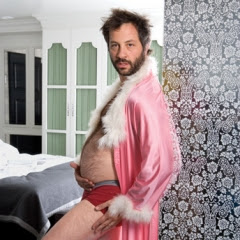
 But then my heart sank as I read about the other comedy he’s producing, unimaginatively called Bridesmaids (release date May 2011). Written by and starring Kristen Wiig, the movie is about “a maid of honor trying to please the snobby, eccentric or really awkward bridesmaids at every pre-wedding event before her best friend’s nuptials.” Given Wiig’s successful comedic record, it’s clear she can hang with the funniest of dudes, and I’m willing to bet she lays down some solid jokes in Bridesmaids, but that type of movie has graced the big screen before with lamer jokes and interchangeable blondes and brunettes – cue the bridezilla, bridesmaid dress fat jokes, Vera Wang and a heart warming, seen-the-error-of-our-ways ending.
But then my heart sank as I read about the other comedy he’s producing, unimaginatively called Bridesmaids (release date May 2011). Written by and starring Kristen Wiig, the movie is about “a maid of honor trying to please the snobby, eccentric or really awkward bridesmaids at every pre-wedding event before her best friend’s nuptials.” Given Wiig’s successful comedic record, it’s clear she can hang with the funniest of dudes, and I’m willing to bet she lays down some solid jokes in Bridesmaids, but that type of movie has graced the big screen before with lamer jokes and interchangeable blondes and brunettes – cue the bridezilla, bridesmaid dress fat jokes, Vera Wang and a heart warming, seen-the-error-of-our-ways ending.



